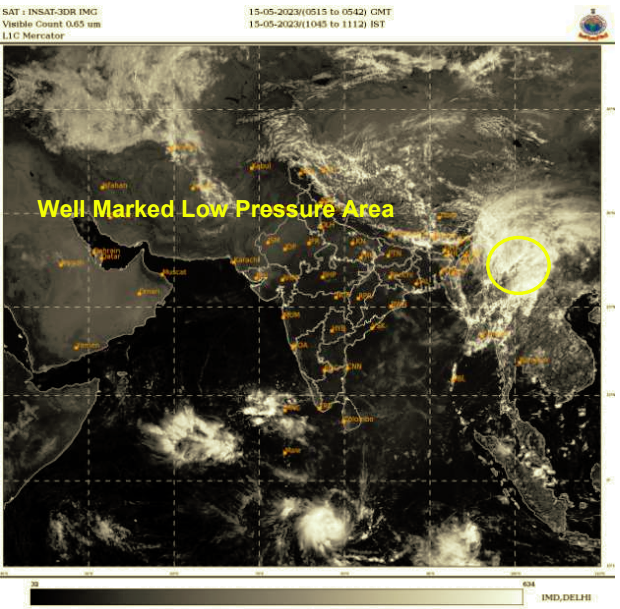
 By Venkatesh Raghavan*
By Venkatesh Raghavan*
Rakhine in Myanmar and Cox’s Bazar in Bangladesh bore the brunt of one of the worst natural calamities in recent years as the ‘very severe’ cyclonic storm Mocha intensified after hitting the coastlines of the two countries, late Sunday evening (May 14, 2023), causing a slew of landslides and floods. The official death toll in Myanmar was reported to be above six.
The depression over Myanmar (remnant of Cyclonic Storm “Mocha” pronounced as “Mokha”) finally moved southeastwards, weakened into a well-marked low-pressure area and lay centred at 0830 hours IST of today, May 15, 2023, over northeast Myanmar and the neighbourhood.
Sittwe, the capital of Myanmar’s Western state, Rakhine – home to Rohingya Muslims, suffered extensive damage to homes and property. The country’s Military Junta pronounced Rakhine a natural disaster area after the estimated loss was placed at 90%. The devastation caused to Myanmar shores was the severest since cyclone Nargis that tore through the southern part of the country had caused more than 1.4 lakh deaths.
new footage of #Mocha in Sittwe #Burma as the very catastrophic eyewall of Tropical Cyclone #Mocha moves in.#MochaUpdate #breaking #Emergencypic.twitter.com/pVhQbfMTts
— StormHQ (@StormHQwx) May 14, 2023
Scores of makeshift shelters in both countries have borne the brunt of the category-five storm.
In coastal Cox’s Bazar in Bangladesh, the world’s largest refugee settlement, thousands of Rohingya refugees from neighbouring Myanmar were rendered homeless, although there was no loss of life as feared earlier. Still, the Rohingyas were the worst sufferers as the Bangladeshi government does not permit these refugees to leave their camps or avail of housing in permanent structures or buildings and hence they had very scant provision for availing shelter. Tarpaulin roofs atop the shabby skeletons of bamboo sticks served as their makeshift relief. However, a few received the facility of community shelters within the camps earmarked for them.
Authorities reported that there were no casualties in the refugee camps though there were some instances of people living in wet conditions without a roof over them owing to tarpaulin cover flying off in the wind. The damage to property in the camp areas included upward of 1200 shelters, 14 mosques and learning centres. Damages were also caused due to tree falls and landslides in many areas. Though the worst that was feared is not yet over, the Bangladesh meteorological department pronounced it as the most severe in two decades.
Alerts being made available through an early warning system enabled authorities in Bangladesh to evacuate 7.5 lakh people to safety before the advent of the storm. At the time of going to press, no casualties were reported from Bangladesh.
The evacuation process in Bangladesh witnessed hundreds of people converging into a school building for shelter from the Cox’s Bazar streets. Consequently, the premise got overly cramped with mothers, babies, elderly persons and young children. All benches and desks in the classrooms got occupied as places to sleep and squat on. Families that arrived at the shelter were forced to carry their cattle, chickens, goats and other livestock in order to ensure their sustenance after the storm brewed over. People from coastal towns and fishing villages had to suffer long travel hours to reach their shelters.
Many among those seeking shelter poured out their tales of woe about being forced to flee from their homes, every time a storm broke through and being unable to bear the expenses of rebuilding their houses due to a shortage of funds. They feared that a repeat of their houses getting submerged might render them homeless.
While the Bangladesh government in accordance with standing orders on disaster (SOD) pronounced that “no major damage has been caused to the country,” the cyclone Mocha’s direct impact seems to have been borne by Myanmar. The torrential downpour caused cutting and disruption of power lines, in addition to houses getting submerged massively in the Rakhine state.
The cyclone that traversed Myanmar stretch at 209 km/hour and wreaked havoc on the camps set up for the displaced Rohingya community in the state. The videos captured showed roofs being blown off houses. In addition, there was severe disruption of electric connections and also wireless networks. The telecom towers were caused to tumble and even the billboards tagged to buildings got ripped off. Amidst this wild spread of mayhem, Myanmar’s Red Cross society is preparing itself to combat the emergency situation.
*Senior journalist





